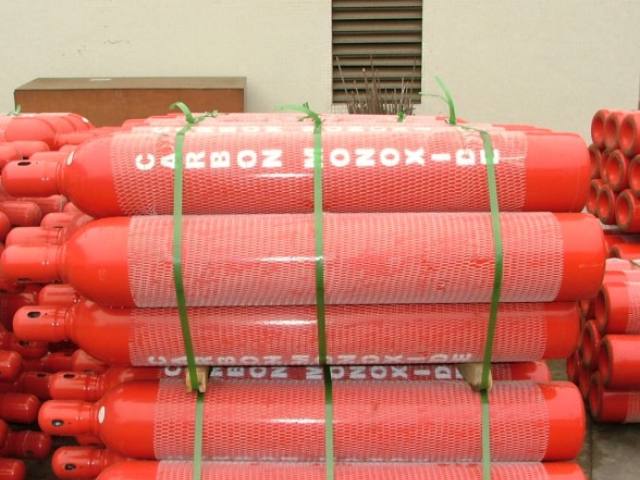Arian gas company activities in supplying different kinds of industrial, laboratory, and medical gases. Arian gas supply imported carbon monoxide gas with 99.5%, 99.9% purity in 50 lit cylinder
- Carbon monoxide (CO)
- Carbon monoxide (CO) gas is formed from the combination of a carbon atom with an oxygen atom. Not only flammable, it is also very hazardous since it is very toxic and odorless. It cannot sustain life and is produced, among other things, from incomplete combustion due to lack of oxygen. It can therefore cause domestic accidents if heating systems are poorly maintained. It is produced on a large scale in industry, in combination with hydrogen, by reforming hydrocarbons, generally natural gas. It is used in large quantities to produce various intermediary organic chemicals, such as acetic acids, isocyanates, formic acid, and also certain polymers such as polycarbonates and polyketones.
- Main applications
- Industries Applications
- Chemicals
- Carbon monoxide and synthesis gas are the raw materials in the polycarbonate, polyurethane and oxy-alcohol manufacture based on SMR and ATR processes or on partial oxidation.
- Carbon monoxide is also used in the manufacturing of metal carbonyls.
- Laboratories & analysis
- Carbon monoxide is used in calibration gas mixtures for petrochemical industry; environmental emission monitoring, industrial hygiene monitors and trace impurity analyzers.
Gas Properties
- Molecular weight : 28.01 g/mol
- Solid phase
- Latent heat of fusion (1,013 bar, at triple point) : 27.873 kJ/kg
- Liquid phase
- Liquid density (1.013 bar at boiling point) : 788.6 kg/m3
- Liquid/gas equivalent (1.013 bar and 15 °C (59 °F)) : 674 vol/vol
- Boiling point (1.013 bar) : -191.6 °C
- Latent heat of vaporization (1.013 bar at boiling point) : 214.85 kJ/kg
Critical point
- Critical temperature : -140.3 °C
- Critical pressure : 34.987 bar
- Critical density : 301 kg/m3
Triple point
- Triple point temperature : -205.1 °C
- Triple point pressure : 0.1535 bar
- Gaseous phase
- Gas density (1.013 bar at boiling point) : 4.355 kg/m3
- Gas density (1.013 bar and 15 °C (59 °F)) : 1.184 kg/m3
- Compressibility Factor (Z) (1.013 bar and 15 °C (59 °F)) : 0.9996
- Specific gravity (air = 1) (1.013 bar and 21 °C (70 °F)) : 0.968
- Specific volume (1.013 bar and 21 °C (70 °F)) : 0.862 m3/kg
- Heat capacity at constant pressure (Cp) (1.013 bar and 15.6 °C (60 °F)) : 0.029 kJ/(mol.K)
- Heat capacity at constant volume (Cv) (1.013 bar and 15.6 °C (60 °F)) : 0.02 kJ/(mol.K)
- Ratio of specific heats (Gamma:Cp/Cv) (1.013 bar and 15.6 °C (60 °F)) : 1.402488
- Viscosity (1.013 bar and 0 °C (32 °F)) : 0.0001662 Poise
- Thermal conductivity (1.013 bar and 0 °C (32 °F)) : 23.027 mW/(m.K)
Miscellaneous
- Solubility in water (1.013 bar and 0 °C (32 °F)) : 0.0352 vol/vol
- Solubility in water (1.013 bar and 20 °C (68 °F)) : 0.0227 vol/vol
- Autoignition temperature : 630 °C
Vapor Pressure Graph
- The vapor pressure curve may be obtained by clicking on the image. On the graph, pressure is in bar or 0.1 MPa, temperature in K or °C. The critical point is indicated by a black spot on the liquid-vapor equilibrium curve.
Major Hazards
- Major hazard : Fire and Inhalation
- Toxicity (Am. Conf. Of Gov. Ind. Hygienists ACGIH 2000 Edition) : 25 ppm
- Flammability limits in air (STP conditions) : 12.5-74 vol%
- Odour : None
- UN Number : UN1016
- EINECS Number : 211-128-3
- DOT Label (USA) : FG
- DOT Hazard class (USA) : Flammable Gas
- Material compatibility
- Air Liquide has assembled data on the compatibility of gases with materials to assist you in evaluating which products to use for a gas system. Although the information has been compiled from what Air Liquide believes are reliable sources (International Standards: Compatibility of cylinder and valve materials with gas content; Part 1: ISO 11114-1 (Jul 1998), Part 2: ISO 11114-2 (Mar 2001)), it must be used with extreme caution. No raw data such as this can cover all conditions of concentration, temperature, humidity, impurities and aeration. It is therefore recommended that this table is used to choose possible materials and then more extensive investigation and testing is carried out under the specific conditions of use. The collected data mainly concern high pressure applications at ambiant temperature and the safety aspect of material compatibity rather than the quality aspect

